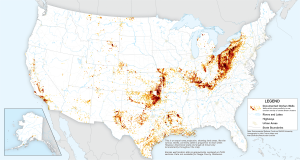New maps unveil scale of U.S. orphan well challenge, highlight solutions at hand
 Last year, for the first time, EDF and McGill University mapped every existing documented orphan well across our country. Shortly after, Congress passed the Infrastructure and Investment Act, IIJA, which included $4.7 billion to document, plug and remediate orphan wells. This new funding, secured through EDF’s leadership, provides federal support for the first time for states, Tribes, and federal land management agencies to find and plug orphan oil and gas wells that are inactive and unplugged with no solvent owner of record.
Last year, for the first time, EDF and McGill University mapped every existing documented orphan well across our country. Shortly after, Congress passed the Infrastructure and Investment Act, IIJA, which included $4.7 billion to document, plug and remediate orphan wells. This new funding, secured through EDF’s leadership, provides federal support for the first time for states, Tribes, and federal land management agencies to find and plug orphan oil and gas wells that are inactive and unplugged with no solvent owner of record.
Prior to this legislation, states, which oversee 90% of the wells in the country, had a fraction of the funding needed to plug wells with the unfortunate result that they often sat unplugged for decades. Now, we’re publishing an updated orphan wells map that draws on newly available data to offer decision makers and the public a clearer picture of the issue.
Uncovering the scale of the issue
The map we published last year had around 80,000 wells, and this year we counted 120,000 in 30 states. This nearly 50% increase from just one year ago is primarily due to increased efforts by states to locate and document these wells to ensure they are eligible for the new federal closure funding — but is still just a fraction of the true count of orphan wells, which may number a million or more. The IIJA included funding for the Department of Energy to work with states in finding, characterizing and prioritizing undocumented orphan wells, so we expect the official counts to fluctuate as old wells are plugged and new wells are found.
New maps unveil scale of U.S. orphan well challenge, highlight solutions at hand Share on XThese new maps show the widespread nature of orphan wells — we calculate that around 14 million Americans live within a mile of one. This matters because these wells pose significant risks to human and environmental health by leaking toxic chemicals into the air, contaminating groundwater and emitting methane, a powerful greenhouse gas. They can also lower property values and land productivity.
Getting ahead of the problem
The new federal investment to plug these wells is a major step forward in addressing the threat these wells pose and to begin plugging them. And the first wells are already being plugged. EDF will stay closely engaged with this program to ensure as many wells as possible are plugged but we must also begin to focus on preventing future orphan wells.
The U.S. has hundreds of thousands of marginal, or “low-producing”, and idle wells, for which states and the Bureau of Land Management hold only pennies on the dollar in financial assurance to pay for plugging in case of operator bankruptcy. That means hundreds of thousands of wells are at risk of becoming orphaned pollution liabilities unless action is taken.
States have begun to recognize the gravity of this problem and take action so today’s low-producing wells don’t become tomorrow’s orphans. These reforms are intended to ensure that all oil and gas wells are plugged in a timely fashion, at the end of their useful lives, with industry money — rather than at taxpayer expense.
These maps are a snapshot in time — what the current documented orphan well count looks like in 2022 — and they don’t include the undocumented orphan wells which cannot yet be mapped. But they can act as a guide to show where the problem is most severe, and serve as a driver for policy change that ensures currently active wells are not added to this map










